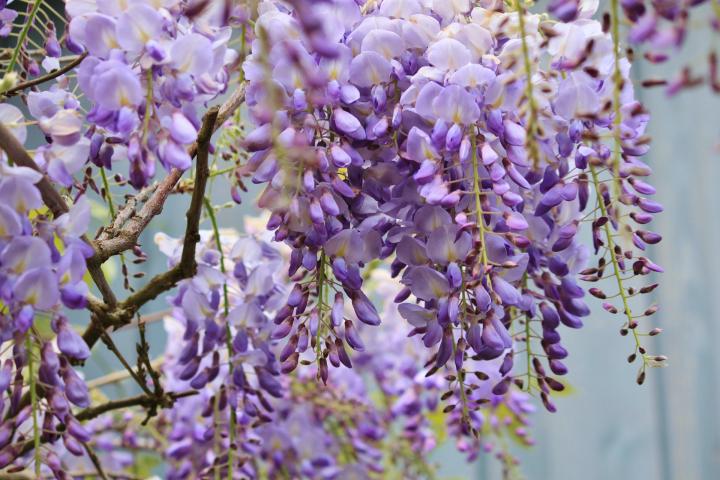
Something between a vine and a shrub, wisteria blooms vigorously in spring with showy, cascading flower clusters that provide quick-growing color.
Wisteria provides the drapery and slipcover to camouflage a view or provide living shade over porch and pergola.
However, note that it can take a good six years for a newly established wisteria to start flowering—sometimes longer!
The vine may grow 10 feet or more in one year! This gives the artful gardener a paintbrush with which to cover the landscape-canvas. Wisteria is also beautifully fragrant providing a feast for the senses.
Note: Some types of wisteria are considered invasive pests; check with your local cooperative extension. All parts of this plant, especially the seeds, are poisonous.
Planting
- Grow in fertile, moist but well-drained soil.
- Ensure placement has full Sun. Though wisteria will grow in partial shade, it probably won’t flower. Sun is essential.
- If your soil is in poor condition, add compost; otherwise, wisteria will grow in most soils.
- Plant in the spring or fall.
- Dig a hole as deep as the root ball and 2 to 3 times as wide. Space plants 10 to 15 feet apart.
- Choose a site that will not overwhelm nearby plants as wisteria grows quickly and can overtake other plants.
Care
- Each spring, apply a layer of compost under the plant and a 2-inch layer of mulch to retain moisture and control weeds.
- Some gardeners swear by phosphorus to aid flowering. Scratch a couple of cups of bone meal into the soil in the spring and then add some rock phosphate in the Fall.
- Water your plants if you receive less than one inch of rain each week. (To know how much rain you are getting, you can place an empty tuna can outside and measure the depth of water with a measuring stick.)
Pruning Wisteria
- Pruning is the secret to good flowering.
- Prune wisteria in late winter. Remove at least half of the prior year’s growth, leaving just a few buds per stem.
- If you want a more formal appearance, prune again during summer after traditional flowering.
- For more blooms, try cutting back the rampant shoots every two weeks during the summer.
- Do you have a new wisteria? Cut the vine back severely right after planting. Then, the next year, cut the main stem or stems back to 3 feet of the previous season’s growth. Once the framework is full size, shorten further extension growth in midsummer to where growth began for that season.
- Informally grown, mature plants need little or no subsequent pruning.
- For a formally trained plant, cut side shoots back to 6 inches in summer, then shorten them again in winter to 3 buds.
- Wisteria will resprout with vigor if cut back severely, but this pruning should be avoided, if possible, because new shoots may take some years before they flower.
- Get more tips for pruning wisteria.
Pests/Diseases
- Dieback, crown gall, leaf spots, virus diseases, Japanese beetle, aphids, leaf miners, scale insects, and mealybugs can be problems.
Recommended Varieties
- W. floribunda (Zones 5 to 9) of Japanese origin, is capable of growing 30 to 60 feet (and beyond in the South).
- ‘Honbeni’ (syn. ‘Honko’) is one of our favorites, bearing clusters of pink flowers in late spring.
- ‘Alba’ (syn. ‘Shiro Noda’) bears lovely clusters of pure-white clusters; it blooms in late spring.
However, note that Asian wisteria is not a “native” and becomes very invasive if not controlled.
- Consider growing the less invasive American wisteria (Wisteria frutescens) which grows in Zones 5 to 9. It’s native to a range of states covering Virginia to Texas, southeast to Florida and north up through New York, Iowa, and Michigan. The vine grows 25- to 30-feet long with shiny dark-green leaves and large, drooping lilac or purple-blue flower clusters which appear after the plant has leafed out. The blooms will only appear on new wood. However, note that the flowers are unscented, unlike the Asian Wisteria.
- Another native American is Wisteria macrostachya (Zones 4 to 9) or Kentucky wisteria. This late-season bloomer is native to the southeastern U.S. and is similar to the American Wisteria. Kentucky Wisteria bears unscented bluish-purple flowers after growing only two to three years, making it the quickest wisteria to bloom.
- ‘Blue Moon’ is an extra-hardy cultivar of native Kentucky Wisteria with showy silvery-blue clusters and blooms in late spring and often again in the summer. It’s cold hardy to -40 degrees Fahrenheit.
Wit & Wisdom
Wisteria still not blooming? Some readers have sworn by this method: Take a shovel and drive it eight to ten inches into the ground about a foot and a half out from the trunk to slice into some of the roots. Damage about ½ of the roots and the bush will be shocked into reproduction. It is very difficult to hurt this rampantly-growing, unrestrained, often invasive plant.






